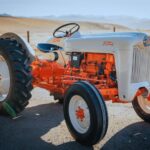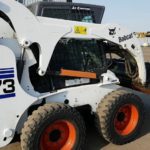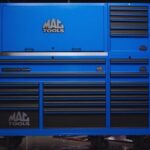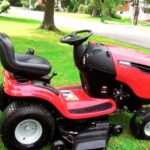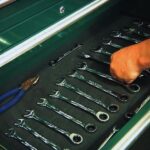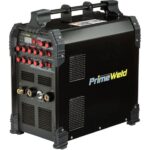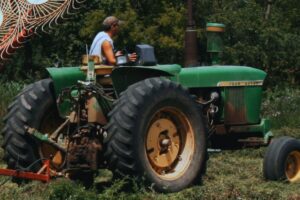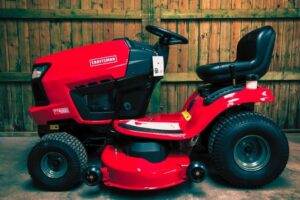One of the most popular tractors is the Ford 800 series. This article will look at the Ford 800 tractor, including its key specs and features.
The Ford 800 series tractors feature identical vertical inline Ford EAF gasoline engines. These engines feature eight valves, four cylinders, and natural aspiration. It features a 2.8-liter displacement with liquid cooling, 14.2 coolant capacity, and a bore and stroke measuring 3.6 x 3.9 inches.
Read on to learn more about the Ford 800 tractor, including its features and specs.
About the Ford 800 Tractor
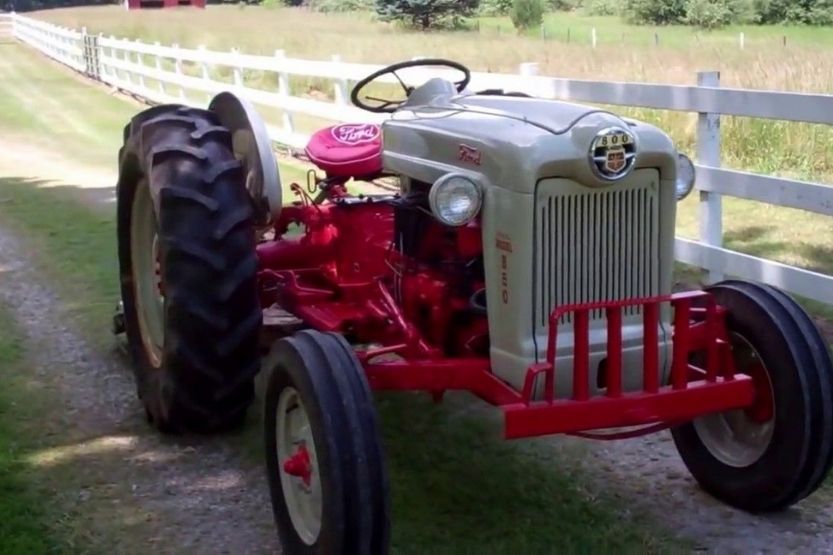
Ford Motor Co. founder Henry Ford started experimenting with tractor design during the early 1900s. It was during this time when he established Fordson. In 1928, Ford opted to stop the production of his tractors in the United States. But he decided to continue its production in England.
Models
There are three models under the Ford 800 Series, namely, 820, 850, and 860. From 1955 to 1957, Ford manufactured 820 models. In contrast, Ford made the 850 and 860 models between 1954 and 1957.
The Ford 800 Series tractors are mainly sold based on their efficiency. Ford claims that using this type of tractor costs about ten cents per hour only because these use diesel. They are 50% more economical than gas tractors. After conducting a test, we found out that it is indeed true. Using a Ford 800 Series Diesel tractor is fuel-efficient.
Most of these Ford tractors’ features are similar to a tractor’s features on a 172 gas engine. It’s just that with the Ford 800 series, the injection pump drops in the hole where the distributor is positioned.
Also, the Ford 800 Series tractors have thicker flywheels. They also modify the crank. But in terms of the engine block’s size, it is of the same size as those on a 172 gas engine.
The price of the Ford gas tractors and diesel tractors are not the same, but the difference is minimal. This way, Ford can allow farmers to choose any type of engine that they wish to have at an affordable cost.
These Ford 800 Series tractors are very durable and definitely of high quality. Those that were bought many years ago by farmers are still up and running 100%.
Should You Buy a Second-Hand Ford 800 Series Tractor?
So, if you are interested in buying a second-hand Ford 800 Series tractor, go ahead and buy it for as long as it is still running. If it isn’t running, it is best to have it checked by a mechanic to determine if you can still restore it.
Do not worry about its parts in case you need to replace some. All Ford 800 tractor parts are still available. If the other parts do not need to be replaced, you can repair or rebuild them, such as the injection pump.
Ford 800 Series Tractor Specs and Features
Let’s briefly discuss the features of the Ford 800 Series tractors according to the following categories:
- Power, Mechanical, and Electrical Features
- Dimensions and Tire Features
- Engine and Transmission Features
1. Power, Mechanical, and Electrical Features
The power, mechanical, and electrical features of the Ford 800 Series tractors are generally the same. If there are any differences, they involve the following:
- 860 model has a live power take-off
- 850 model has a transmission power take-off
- 820 model has no 3-point hitch or hydraulics
The 850 and 860 models have 540 rear revolutions per minute (rpm). They also have a single 3-point hitch with a lift capacity of 1,250 lbs.
Each of the models has three 14-inch plows as well as a claimed belt power of 40 horsepower. The tested drawbar and belt power integrated into the 850 model includes 35.16 and 39.55 horsepower, respectively. In contrast, the tested drawbar and belt powers of the 860 model are 39 and 45.41 horsepower, respectively.
Each model features a 4 x 2, 2-wheel drive with manual steering when it comes to chassis. They also feature differential mechanical expanding shoe brakes as well as an open operator cab station. Should you prefer to have a power steering feature, it is possible but is optional.
All models are also equipped with positive electrical grounds, single 6-volt batteries, and 20-amp generator charging systems.
2. Dimensions and Tire Features
The Ford 820, 850, and 860 Series tractors weigh approximately 3,400 lbs. But they have a weight capacity of 6,700 lbs.
Both the 850 and 860 models have the same dimensions. They measure 59.3 inches in height, 64.75 inches in width, and 121.8 inches in length. Their ground clearances measure 21 inches, while their wheelbases measure 75.18 inches.
In terms of the front and rear treads, they measure 76 x 72 inches. The front tires for the Ford 850 and 860 measure 6 x 16 inches, while the rear tires measure 12 x 28 inches.
The Ford 820 Series tractor is smaller than the 850 and 860 models. Its wheelbase measures 55.5 inches in height and 113.6 inches in length. As for its ground clearance, it measures 19 inches.
As for Ford 820’s front tread, it measures 52 x 80 inches. In contrast, its back tread measures 48 x 76 inches. In terms of its front tires, the dimensions are 6 x 16 inches. Moreover, the rear tires measure 10 x 28 inches.
3. Engine and Transmission Features
The Ford 800 series tractors are equipped with identical vertical inline Ford EAF gasoline engines. These engines feature eight valves, four cylinders, and natural aspiration. It features a 2.8-liter displacement with liquid cooling, 14.2 coolant capacity, and a bore and stroke measuring 3.6 x 3.9 inches.
All models feature 2,200 rated revolutions per minute (rpm) and a compression ratio of 6.75:1. They are equipped with an oil bath air cleaner, have an oil capacity of 4.7 liters, and have 6 starter volts.
The three models feature unsynchronized gear transmissions. These consist of five forward, one reverse gear, and one dry disc clutch.
Below is a great Ford 800 tractor restoration video – making the classic Ford 800 tractor new again:
Developments in Tractor Technology
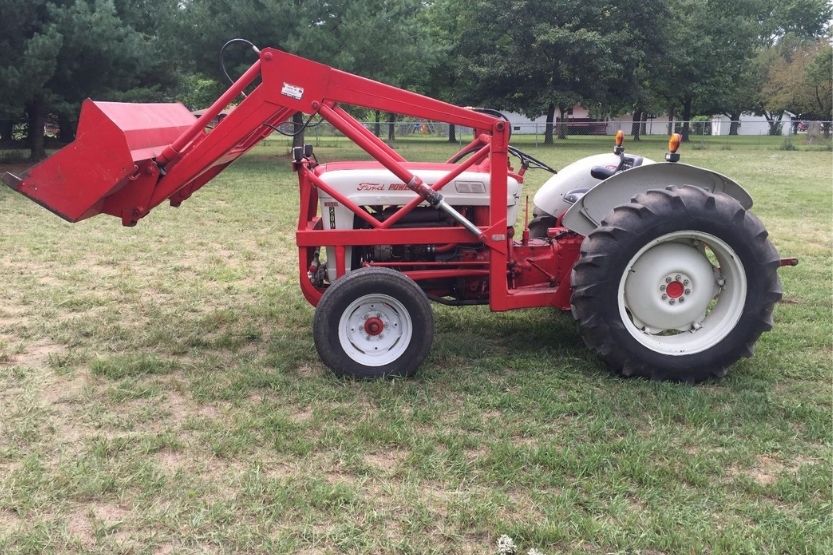
Tractors were developed mainly for farming and other agriculture projects. The versatility of tractors allows farmers to do the following with convenience:
- Clearing the land,
- Trenching,
- Sowing, and
- Digging, among many others.
This utility vehicle undoubtedly makes farming easier to do. With tractors, farmers do not worry that the soil underneath will get damaged during harvesting, propagation, and land preparation.
While farmers are already satisfied with the tractor’s original features, manufacturers have started to incorporate smart technology into newer models. Now, tractors are more convenient to operate, and they include improved tracking information. Modern versions have sprayers too.
Other types of technology incorporated in some tractor models are anti-dive functionalities, project planning and tracking, and data sharing. They are also now equipped with suspended axle technology and other automated features.
John Deere 4430 Specs and Review
How to Choose the Right Tractor
There is no specific tractor that will address the needs of all farmers. Each farmer has a different set of preferences. Therefore, an ideal tractor for one farmer may not at all be perfect for another farmer.
There are several factors to consider when looking for the ideal tractor for you. These include the following:
- How much tractor power is needed
- Brand New or Second Hand Tractor
- Type of Work
- Site’s terrain or landscape
- How will you transport the tractor to the site
- Do you need extra wheels for extra traction?
- Is a 2-wheel drive enough for your farming projects, or do you need a 4-wheel drive to complete your job?
Type of Work
It is important to identify what type of work is usually done on your farm. As I have earlier mentioned, if you are a hobby farmer or you have small land, a small tractor is most likely the ideal one for you. But if you will be hauling large implements for farming, you might have to opt for the large one.
Before buying a tractor, list down the features that you want your tractor to have. For instance, will you need a UHF radio? Is an air conditioning system necessary? Does your tractor need high-flow hydraulics?
Brand New or Second-Hand?
Another factor to consider is whether you want to buy a brand-new tractor or you can settle for a second-hand one. Of course, any farmer wants to own a brand-new tractor. But there are second-hand tractors available in the market, and most of them still function really well. This is because tractors are durable and will last for so many years if given proper maintenance.
For example, you should be able to find many second-hand Ford 800 tractors. They might require minor repairs, but most Ford 800 tractors have been reliable for years.
Tractors are not easy to restore, but it is feasible. Most tractor parts, if not all, are still available. That’s why repair or restoration is feasible.
If you are considering buying a used tractor, it is best to have a professional mechanic look at the unit’s condition. You are most likely capable of identifying minor and major dents, cracks, and damage on tires. But you might need extra help when it comes to the condition of the engine.
As for the brand new tractor, among the specs that you should check are the following:
- Engine power
- Condition of the wheel and track
- Hydraulics
- Power take-off
- Transmission
- 3-point hitch lift capacity
What Do Consumers Say About the 1086 International Harvester?
Conclusion – Ford 800 Tractor Review
The Ford 800 series tractors are equipped with identical vertical inline Ford EAF gasoline engines. These engines consist of eight valves, four cylinders, and natural aspiration. It features a 2.8-liter displacement with liquid cooling, 14.2 coolant capacity, and a bore and stroke measuring 3.6 x 3.9 inches. These are just some of the best features of the Ford 800 series tractors.
There is no denying that Ford 800 Series tractors are highly durable. But more than anything else, what Ford boasts of when it comes to this utility vehicle is its efficiency.
To help you choose the right tractor for you, here are things you should consider before getting one:
- How much tractor power is needed
- Brand New or Second Hand Tractor
- Type of Work
- Site’s terrain or landscape
- How will you transport the tractor to the site
- Do you need extra wheels for extra traction?
- Is a 2-wheel drive enough for your farming projects, or do you need a 4-wheel drive to complete your job?
Read next:

